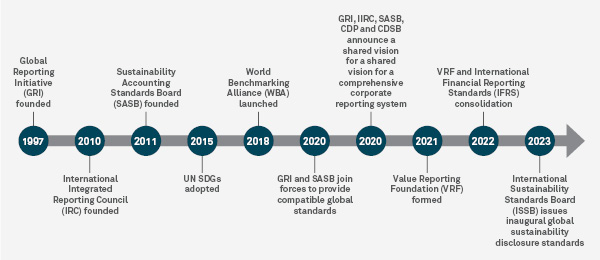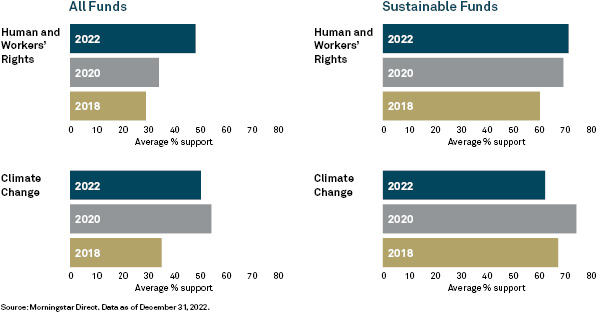Investors must ensure their fund managers are meeting their responsible investing (RI) objectives and know how to avoid companies that are more talk than action when it comes to strong RI practices.
Increased interest in responsible investing has led to many investment products being labelled responsible, sustainable, ESG and/or impact. But how can investors be sure their investments are truly responsible? Understanding the concept of “greenwashing,” and knowing how to avoid it, is key to answering this question.
Conceptually, greenwashing refers to corporations inaccurately exaggerating and potentially misleading investors into believing their environmental, social and governance (ESG) products, processes and policies are sound. The concept has been around since the 1960s, when the nuclear power industry, anxious to remain competitive during the anti-nuclear movement, positioned its power source as a cleaner, safer energy alternative. But the term was actually coined in 1986, in response to hotels that encouraged customers to reuse towels without meaningful environmental initiatives.1 At BNY Mellon, we use the term Responsible Investing to encompass various approaches investors take to incorporate their values, financial materiality driven ESG concerns and/or sustainability and impact goals.
As consumers and investors continue to express an appetite for more responsible products, companies have been searching for ways to attract the green consumer, as well as the wave of investment inflows into ESG-focused stocks and corporate bonds.
A 2015 Nielsen consumer poll found that 66% of people were willing to pay more for eco-friendly products and 50% of purchasing decisions are influenced by sustainability features.2 More recently, a 2020 McKinsey U.S. consumer sentiment survey revealed that more than 60% of respondents would pay more for sustainable packaging.3 Meanwhile, $35.3 trillion worth of assets under management are invested sustainably across the U.S., Europe, Japan, Canada, Australia and New Zealand as of January 2020, a 15% increase in just two years.4 The pace of responsible investing growth surged in the wake of the pandemic, with assets in sustainable funds hitting $304 billion in the U.S. by the end of June 2021, nearly double the $159 billion record set the year before.5 While the pace of inflows has slowed, as of the March 2023, global sustainable fund assets has reached $2.74 trillion.6
Lack of Standardization
With such a rapid growth of assets under management in responsible investments, it’s easy to see how some investment managers may rush product launches and increase RI marketing, even if they lack responsible investment expertise.
Unfortunately, this has occurred at a time when there’s no consensus on the terminology used for different responsible investing strategies. The industry is not aligned on what corporations should be disclosing and there are differing opinions on what criteria should be used to assign RI performance scores on publicly listed companies. Together the fight for market share in responsible investment products and the lack of standardization have led to an emergence of greenwashed investment solutions.
In March 2021, the SEC announced the creation of its Climate and ESG Task Force to develop initiatives to proactively identify ESG-related misconduct consistent with increased investor reliance on climate and ESG-related disclosure and investment. 2022 SEC enforcement actions included two mining companies and a healthcare company that misled investors as well as three investment advisors charged with ESG related misstatements, failure to follow policies and procedures and misleading investors.7
This underscores the importance of both investors and investment managers to articulate their objectives clearly, and ensure their interests are aligned. A strong due diligence framework can help investors avoid greenwashing while the adoption of industry standards and frameworks can reduce its occurrence.
Over the years, industry bodies have been formed to develop standards and frameworks around responsible investment. Recently, some of these groups have joined forces to enable greater reach and better consensus on the topic.

Most notably, the International Integrated Reporting Council (IIRC) and Suitability Accounting Standards Board (SASB) merged in June 2021 to create the Value Reporting Foundation (VRF), an integrated reporting framework with accounting standards with the goal of supporting businesses and investors by developing a shared understanding of enterprise value and how it’s created and preserved (or eroded) over time.8 In November 2021, the IFRS (International Financial Reporting Standards) created the ISSB (International Sustainability Standards Board) to focus on creating a comprehensive global baseline of sustainability disclosures. Further, in August 2022, the VRF was consolidated into the IFRS Foundation in effort to consolidate leading global sustainability disclosure initiatives and support ISSB’s initiative. Another recent development was the launch of the U.S. Investment Consultants Sustainability Working Group (ICSWG-US) in May 2021. ICSWG-US is a collaborative effort of investment consulting firms, intended as a resource on activities such as the standardization of ESG integration. Additionally, the CFA Institute has developed Global ESG Disclosure Standards for Investment Products to establish disclosure requirements for investment products with ESG-related features.
Align Objectives
The development and adoption of standards and common frameworks are critical steps toward reducing greenwashing. But the onus remains on the investor and their advisors to understand what they are investing in.
Identifying greenwashed investment solutions requires an understanding of the underlying investment managers’ commitment to responsible investment, as well as their approach and objectives. The manager must be able to explain how the strategy works to achieve its responsible investment goals.
For example, negative screening may be appropriate to ensure a portfolio does not invest in companies whose products or services conflict with an investor’s personal values – and it’s relatively easy for a manager to illustrate their portfolio has no exposure to specific issue areas. Yet, it’s more difficult for a manager to illustrate the positive effects on long-term risk-adjusted performance by analyzing corporate ESG metrics to identify material ESG risks and opportunities. Beyond performance, it is even more difficult to illustrate the intentional impact of capital on specific desired outcome. A strong investment due diligence framework is crucial to understanding these nuances.
How to Navigate
In a market where RI products are proliferating, investor scrutiny is essential to differentiating between products that do the bare minimum to technically achieve their RI labels, and those that truly analyze and integrate RI elements into the investment approach. For example, if a manager states that they integrate ESG for risk mitigation and/or return enhancement, they should be able to describe their research process and the resources used to identify the material risks and opportunities, as well as articulate how the research affects their investment decisions. In addition, a manager that is an active owner and casts proxy votes should be able to illustrate how its proxy policies and voting records align with the responsible investing principals of the strategy or firm.
The Manager Research team at BNY Mellon leverages a due diligence framework with specific, dedicated responsible investing factors. These six factors allow for thorough examination of investment manager commitment, philosophy, process and implementation of a responsible investment approach.

The manager research due diligence process involves interviewing many investment professionals including Chief Investment Officers, portfolio managers, research analysts and investment risk to uncover details around the investment strategy’s approach to responsible investing. Some key assessments include:
· Is the approach clearly defined and compelling in the context of the RI objective the strategy is trying to achieve? For example, for strategies seeking positive measurable impact, evaluation of the ability to achieve impact goals and understand the scope and scale of the strategy’s impact is important.
· What resources are available and leveraged as part of the RI/ESG evaluation process? Are there separate research teams or is the RI/ESG research embedded in the traditional investment analysts and portfolio management functions?
· How do the ESG risk/opportunities identified by the investment team impact decision making, particularly in the sizing of individual positions and in the decision to invest or not invest in a name based on material ESG issues identified by the investment team?
· How much ability does the manager have to influence change and encourage portfolio companies to improve on their ESG profile through ongoing and active engagement and proxy voting on RI related matters?
· What form of reporting does the manager provide to validate their RI approach? A process of measuring, monitoring and disclosing RI metrics and/or engagement process provides further confidence in validating a manager’s RI approach.
Generally, we find that managers who have sustainable fund mandates vote in favor of ESG related shareholder proposals. Based on an internal analysis of Morningstar’s U.S. large cap mutual funds proxy data, sustainable funds appear to support ESG-related proposals more often, but support across all funds has increased from 2018 to 2022. Although, support for climate-related proposals has lessened, likely due to over-prescriptive proposals.

This shift in behavior can be partly attributed to increased consumer and investors awareness of ESG issues and their potential impact on long-term company success. Demand will inevitably drive industry standards forward, and investors and regulators will increasingly not tolerate greenwashing in an investment management context.
The risk of greenwashing will likely persist in some form until there is consensus on the terminology related to responsible investing, standardized disclosure, and common frameworks. In the meantime, it is important for investors and their advisors to speak the same language in deploying healthy skepticism in evaluating RI solutions. Investors should discuss their goals with their advisors to identify the best solutions that align their investments with values.
Footnotes
1 “What Is Greenwashing: Differentiating Between Sustainable & Sellable,” Sustainable Jungle, February 13, 2023. Accessed August 1, 2023.
2 Ibid.
3 “Consumers Care About Sustainability—and Back It up With Their Wallets,” McKinsey & Company and NielsenIQ, February 6, 2023. Accessed August 1, 2023.
4 “Global Sustainable Investment Review 2020,” Global Sustainable Investment Alliance. Accessed August 1, 2023.
5 “U.S. Sustainable Fund Assets Reach a New Milestone in 2021’s Second Quarter,” Morningstar Direct. Accessed August 1, 2023.
6 “Global Sustainable Fund Flows: Q1 2023 in Review,” Morningstar Direct. Accessed August 1, 2023.
7 “Enforcement Task Force Focused on Climate and ESG Issues,” U.S Securities and Excange Commission. Accessed August 1, 2023.
8 “IIRC and SASB Form the Value Reporting Foundation, Providing Comprehensive Suite of Tools to Assess, Manage and Communicate Value,” IFRS Foundation, June 9, 2021. Accessed August 1, 2023.
This material is provided for illustrative/educational purposes only. This material is not intended to constitute legal, tax, investment or financial advice. Effort has been made to ensure that the material presented herein is accurate at the time of publication. However, this material is not intended to be a full and exhaustive explanation of the law in any area or of all of the tax, investment or financial options available. The information discussed herein may not be applicable to or appropriate for every investor and should be used only after consultation with professionals who have reviewed your specific situation.
The Bank of New York Mellon, DIFC Branch (the “Authorized Firm”) is communicating these materials on behalf of The Bank of New York Mellon. The Bank of New York Mellon is a wholly owned subsidiary of The Bank of New York Mellon Corporation. This material is intended for Professional Clients only and no other person should act upon it. The Authorized Firm is regulated by the Dubai Financial Services Authority and is located at Dubai International Financial Centre, The Exchange Building 5 North, Level 6, Room 601, P.O. Box 506723, Dubai, UAE.
The Bank of New York Mellon is supervised and regulated by the New York State Department of Financial Services and the Federal Reserve and authorized by the Prudential Regulation Authority. The Bank of New York Mellon London Branch is subject to regulation by the Financial Conduct Authority and limited regulation by the Prudential Regulation Authority. Details about the extent of our regulation by the Prudential Regulation Authority are available from us on request. The Bank of New York Mellon is incorporated with limited liability in the State of New York, USA. Head Office: 240 Greenwich Street, New York, NY, 10286, USA.
In the U.K. a number of the services associated with BNY Mellon Wealth Management’s Family Office Services – International are provided through The Bank of New York Mellon, London Branch, One Canada Square, London, E14 5AL. The London Branch is registered in England and Wales with FC No. 005522 and BR000818.
Investment management services are offered through BNY Mellon Investment Management EMEA Limited, BNY Mellon Centre, One Canada Square, London E14 5AL, which is registered in England No. 1118580 and is authorised and regulated by the Financial Conduct Authority. Offshore trust and administration services are through BNY Mellon Trust Company (Cayman) Ltd.
This document is issued in the U.K. by The Bank of New York Mellon. In the United States the information provided within this document is for use by professional investors.
This material is a financial promotion in the UK and EMEA. This material, and the statements contained herein, are not an offer or solicitation to buy or sell any products (including financial products) or services or to participate in any particular strategy mentioned and should not be construed as such.
BNY Mellon Fund Services (Ireland) Limited is regulated by the Central Bank of Ireland. BNY Mellon Investment Servicing (International) Limited is regulated by the Central Bank of Ireland.
Trademarks and logos belong to their respective owners.
BNY Mellon Wealth Management conducts business through various operating subsidiaries of The Bank of New York Mellon Corporation.
©2023 The Bank of New York Mellon Corporation. All rights reserved. | WM-410542-2023-08-01
